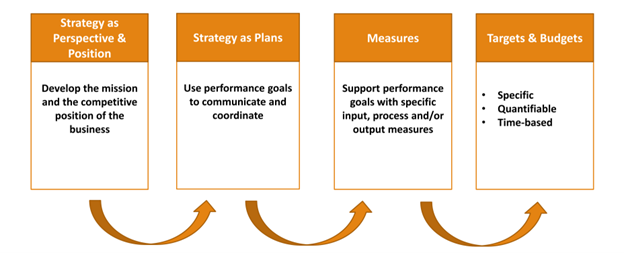1 Introduction
1.1 Why have a data-driven decision-making course?
1.1.1 Data analytics unlock the potential of data
To answer this question, consider, for example, the four common elements of any control process:
- Establishing Performance Standards.
- Measuring the Actual Performance.
- Comparing Actual Performance to the Standards.
- Taking Corrective Action.
In executing all these elements, decisions must be made. Ideally, such decisions are based on data. These days, most firms collect data all the time. This data can be very valuable if used well. However, in its raw form data is useless. You cannot stare at a three-terabyte large customer data table and expect to see a better marketing strategy immediately. Raw data needs to be structured and aggregated just the right way to yield insights. This is where data analytics comes in. Data analytics takes raw data and then structures and aggregates it to find meaningful data patterns. Those data patterns can be used to make better business decisions.
1.1.2 Because data-driven thinking is not intuitive
Data analysis is hard and requires a certain mindset. It is frequently discussed as a big impediment to unlocking the value of the data companies hold:
Organizations are investing trillions to become more data-driven, but only 8% successfully scale analytics to get value from their data, according to McKinsey —Forbes, Tableau “5 ways to grow business value through analytics”
For the 4th consecutive year, over 90% of executives—91.9% in 2022—point to culture as the greatest impediment to [becoming data-driven]. Only 8.1% cite technology limitations as the primary impediment. —New Vantage Partners, Data and AI Leadership Executive Survey 2022
1.1.3 From data analytics to better decisions
However, data analytics is just one aspect. It is one thing to find patterns in the data. However, a different skill set helps you determine whether these patterns contain new insights and how to make sensible decisions based on the patterns. This is the more difficult part. Many people can crank out massive amounts of useless dashboards. Drawing the right conclusions from those patterns is difficult, requires careful thinking, and expert knowledge in the problem domain. And this is why we have this course. Our course is tailored to business and related questions, for which you need a unique combination of analysis techniques and business expert knowledge to make good decisions.
1.2 Types of decision problems and accompanying questions
What are typical business decisions you’ll encounter? Let’s consider the job of a controller for a change. To show that data analysis is not restricted to marketing departments and quantitative finance. Controlling departments face very specific decision problems. For example, consider the budgeting and forecasting process:

A controlling department actively involved in setting and monitoring a firm’s strategy and performance will face numerous challenging questions. Each question is tied to a decision to be made. Here are just a few examples:
| Question | Decision |
|---|---|
| What would be the operating profitability of opening a typical store in France? | Whether to expand operations to France? |
| How would our revenues and costs be affected if Russia invades Ukraine? | How much effort to allocate to contingency planning? |
| What are reasonable benchmarks for the cost allocation of overhead? | How to best allocate costs for controlling purposes? |
| How would our most profitable customer segment react if we serve them exclusively via an online channel? | Whether to change a part of the business strategy? |
| What is the most “at risk” driver of the net margin of our blockbuster product? | Whether profitability of the main product is “safe” enough or needs action? |
For many of the decisions listed in Table 1.1, the question asked is just one of a collection of important questions for an overall decision. In most cases, it is also not immediately obvious how you would use data to answer these questions. Exactly for that reason we recommend starting any analysis by carefully thinking about the question you need an answer to. Next, we will discuss a decision-making framework (section Chapter 2). The opposite, starting from the data, is often not advisable. You can (and often should) look at many different data sources to find answers to a question. If you start with the data at hand, you might get misleading conclusions because you analyzed inadequate, but readily available, data. For those and many other reasons, our framework starts with thinking carefully about the business question to be analyzed.
1.3 Summary: What this course teaches you
In today’s economy, most firms collect large amounts of data that have the potential to increase decision-making quality inside firms greatly. To properly digest and leverage data, a firm needs employees who are not only well-versed in data analytics (being able to find meaningful patterns in the raw data) but also draw the right conclusions from the patterns, formulate adequate decisions, and report the conclusions and decisions concisely and transparently. In this course, we will cover all of these aspects.